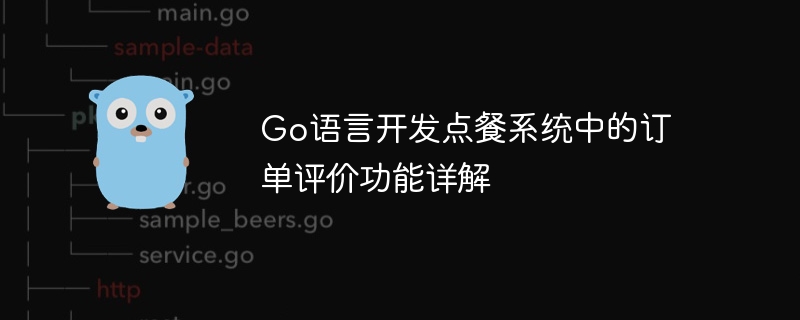Home >Backend Development >Golang >Detailed explanation of the order evaluation function in the food ordering system developed with Go language
Detailed explanation of the order evaluation function in the food ordering system developed with Go language
- 王林Original
- 2023-11-01 09:21:581483browse

Detailed explanation of the order evaluation function in the Go language development ordering system
Introduction:
With the development of the Internet, takeout and ordering platforms have become part of people's daily lives. After completing the order, users often leave comments on the food they ordered for reference by other users.
This article will introduce in detail how to use the Go language to develop the order evaluation function in an ordering system, including the data structure design of the evaluation, implementation ideas, and corresponding code examples.
1. Evaluation data structure design:
Before starting to write code, we first need to design the evaluation data structure. For an order evaluation function, common data fields include evaluation id, order id, evaluation content, evaluation score, evaluation time, etc.
In the Go language, we can use a structure to define such an evaluation object. The sample code is as follows:
type Evaluation struct {
ID int
OrderID int
Content string
Score float32
Time time.Time
}In the above definition, we used time.TimeType to represent the time of evaluation. The time package in Go language provides methods and functions for processing time and date.
2. Ideas for implementing the evaluation function:
In the ordering system, after the user completes the order, the system will generate a unique order ID for the user. When the user evaluates this order, he should first determine whether the order exists, and then perform the evaluation operation if it exists.
To this end, we can define a global evaluation list evaluations to store all evaluation objects. When a user evaluates an order, the system will traverse the orders in the order list, find the corresponding order and generate an evaluation object, and finally add the evaluation object to the evaluation list.
The following is a code example of a basic evaluation function:
func AddEvaluation(orderID int, content string, score float32) {
for _, order := range orders {
if order.ID == orderID {
eval := Evaluation{
ID: len(evaluations) + 1,
OrderID: orderID,
Content: content,
Score: score,
Time: time.Now(),
}
evaluations = append(evaluations, eval)
fmt.Println("评价成功!")
return
}
}
fmt.Println("该订单不存在!")
}
func main() {
// 示例添加一个订单
orders = append(orders, Order{
ID: 1,
UserID: 1001,
Food: "汉堡",
Price: 20.0,
Time: time.Now(),
Completed: true,
})
// 示例评价一个订单
AddEvaluation(1, "汉堡很好吃!", 5.0)
}In the above example code, we first define a global order list orders to store All order objects. In the AddEvaluation function, we traverse the order list, find the corresponding order, generate an evaluation object, and add it to the global evaluation list evaluations. Finally, we demonstrated how to add an order and evaluate this order in the main function.
Summary:
This article introduces in detail how to use Go language to develop the order evaluation function in an ordering system. By designing the evaluation data structure and implementing the corresponding function code, we can easily provide users with evaluation services. Of course, this is just a basic example, and more functionality and security issues need to be considered in actual applications. I hope this article is helpful to you, thank you for reading!
The above is the detailed content of Detailed explanation of the order evaluation function in the food ordering system developed with Go language. For more information, please follow other related articles on the PHP Chinese website!
Related articles
See more- What microservice frameworks are suitable for Go language development?
- Methods to solve security issues in Go language development
- Methods to solve the memory overflow detection problem in Go language development
- Go language development tips: Alibaba Cloud interface docking practice sharing
- Using go language to develop Baidu Translation API to realize mutual translation between Chinese and Moroccan

